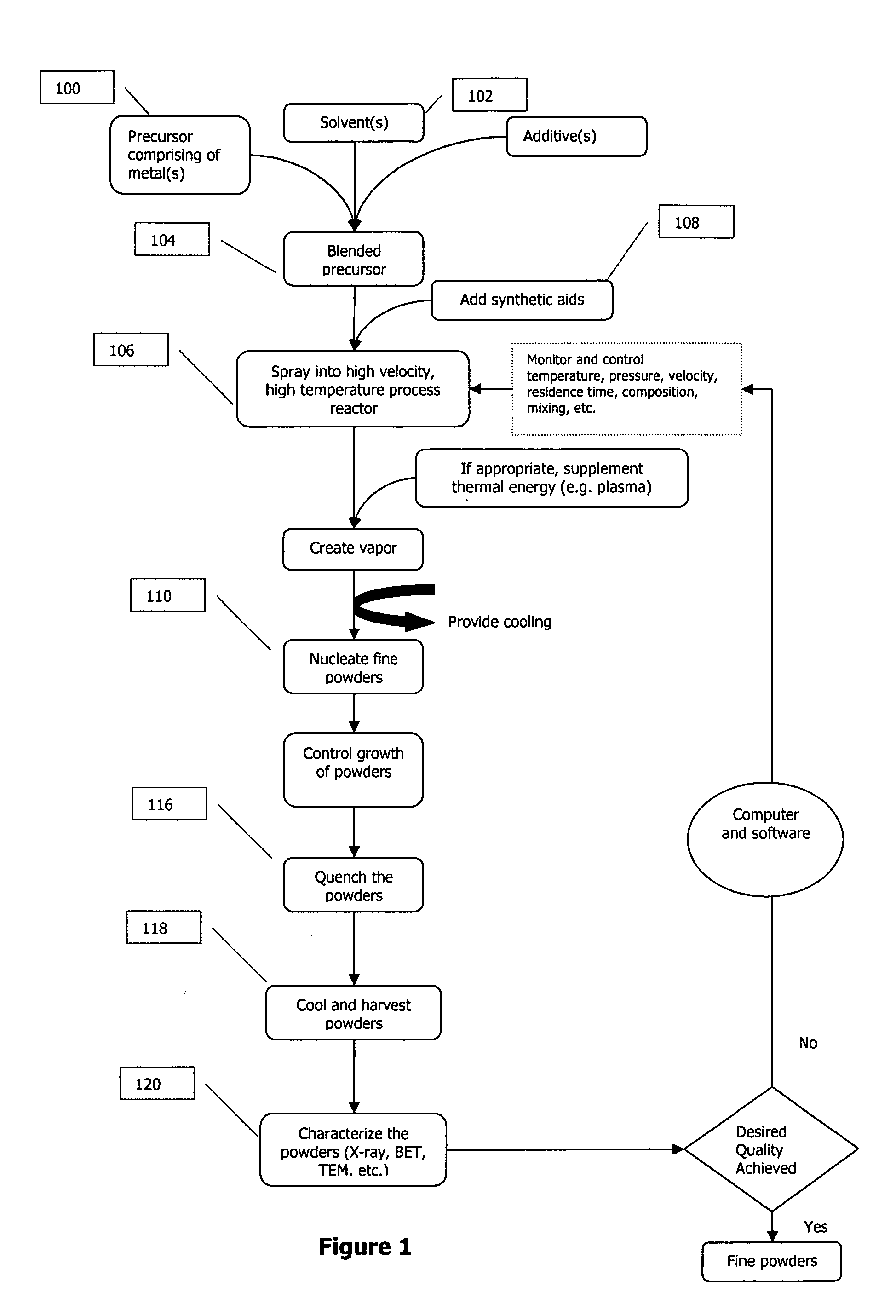Silver comprising nanoparticles and related nanotechnology
- Summary
- Abstract
- Description
- Claims
- Application Information
AI Technical Summary
Benefits of technology
Problems solved by technology
Method used
Image
Examples
examples 1-3
Silver Powders
99.9+weight % by metal pure silver nitrate precursor was dissolved in water and isopropyl alcohol until the viscosity of the precursor was less than 100 cP. This mix was sprayed into a thermal plasma reactor described above at a rate of about 50 ml / min using about 80 standard liters per minute oxygen. The peak vapor temperature in the thermal plasma reactor, processed at velocities greater than 0.25 mach, was above 3000 K. The vapor was cooled and then quenched by Joule-Thompson expansion. The powders collected were analyzed using X-ray diffraction (Warren-Averbach analysis) for spectra, phase and peak broadening; and BET analyzer for surface area. It was discovered that the powders had a crystallite size of less than 50 nm and a specific surface area of greater than 1 m2 / gm.
The precursor was diluted further with the alcohol and water mix and then the run repeated. It was discovered that the powders had a crystallite size of less than 30 nm and a specific surface a...
example 4
Silver Nanoparticles
A hundred liter raw material batch was prepared by mixing 18.4 kgs of silver nitrate (>99.9% purity) into 48 kgs of demineralized water. Next, 40 kgs of isopropyl alcohol were added to the silver nitrate dissolved in the water. This yielded about 100 liters of silver comprising raw material. The silver comprising precursor mix was then combusted in 99%+pure oxygen in the presence of argon-based DC thermal plasma in a reactor operating between about 0.1-0.75 atmospheres. The maximum feed velocity and gas processing velocities were above 0.1 mach, and the peak processing temperatures were above 3200 K. The vapor was cooled to nucleate nanoparticles and then quenched using Joule Thompson effect as taught in co-owned U.S. Pat. No. 5,788,738. The powders were collected on a conductive polymer membrane filtration system. The collected powders were analyzed and were found to be pure silver and have a X-ray crystallite size less than 40 nanometers and a surface area gr...
example 5
Silver Coated Silica Nanoparticles
About 16.3 grams of silica nanoparticle dispersion (12 nanometers) in isopropyl alcohol was mixed with about 10 grams of glycerol in a beaker. To this dispersion, about 10.5 grams of silver nitrate (>99.99% purity) was dissolved. The beaker was wrapped in aluminum foil to prevent light driven reactions. The dispersion was warmed to 75° C. to ensure that the nitrate was completely dissolved yielding a transparent dispersion with a light brown tint. The solution was then heat treated for 1 hour at 450° C. in open atmosphere. About 11.9 grams of fluffy powder was collected. The powder was analyzed with X-ray diffractometer and strong silver metal peaks were observed. The surface area using 5 point BET analysis was greater than 90 m2 / gm. The powder was examined under a high resolution transmission electron microscope and was observed to be non-amorphous, and it lacked atomic disorder (Example-7 is the only SiO2 / Ag powder that was sent for TEM). A ther...
PUM
| Property | Measurement | Unit |
|---|---|---|
| Percent by mass | aaaaa | aaaaa |
| Percent by mass | aaaaa | aaaaa |
| Percent by mass | aaaaa | aaaaa |
Abstract
Description
Claims
Application Information
 Login to View More
Login to View More - R&D
- Intellectual Property
- Life Sciences
- Materials
- Tech Scout
- Unparalleled Data Quality
- Higher Quality Content
- 60% Fewer Hallucinations
Browse by: Latest US Patents, China's latest patents, Technical Efficacy Thesaurus, Application Domain, Technology Topic, Popular Technical Reports.
© 2025 PatSnap. All rights reserved.Legal|Privacy policy|Modern Slavery Act Transparency Statement|Sitemap|About US| Contact US: help@patsnap.com



